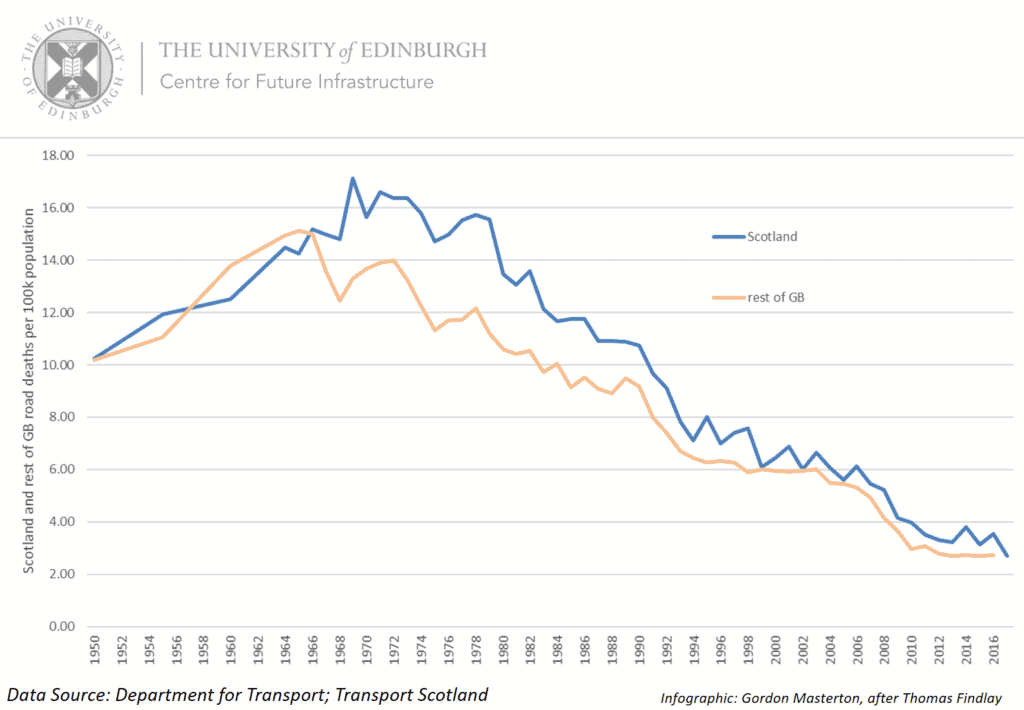Reducing road accident deaths is one of the UN’s early Sustainable Development Goals, with a target date of 2020. The G7 Countries are already trending to miss the target. Professor Gordon Masterton asks whether Scotland could do better?
Provisional data for 2017 has been published by Transport Scotland.
Fig 1 plots road death rates per 100,000 population for both Scotland and the rest of Great Britain since 1950.

Between 1950 and 1966, the (worsening) performance trends were broadly similar. The rest of GB began its turnaround to steady improvement in 1966 but Scotland lagged by three years. Although Scotland’s improvement was steady thereafter, it took about thirty years to get closer to parity with the rest of Great Britain. Perhaps the rate of roll out of the motorway network took longer for Scotland to see material benefits. Scotland has never quite attained the same standard consistently as the rest of GB since 1966, but its rate of improvement has been higher since 1969.
The good news is that the probability of a Scottish resident being killed in a road traffic accident today is 1/6 of what it was in 1969, despite there being 2.7 times more licensed vehicles on the roads .
Let’s look more closely at recent years and focus on the SDG metric of absolute numbers.
Fig 2 shows Scotland’s road deaths since 2000. There were 146 fatalities on Scottish roads, the lowest ever.
Fig 2 also looks forward to 2020 with targets shown. It appears possible to reach the SDG target if it is accepted as such and efforts are focussed.

The European Union has agreed a target of reducing road deaths by 50% from 2010 levels by 2020 . This target has been added to Fig 2. It is less stretching than the SDG Target but more ambitious than the Scottish Government target.
Transport Scotland’s 2016 Strategic Road Safety Plan maintains the less ambitious target set in 2009, with no acknowledgement yet of either the EU or the SDG Targets .
How is Scotland benchmarked against its peers? Scotland’s road safety death rate (by population), is better than the other G7 countries (Fig 3), although the performance gap has narrowed significantly since the early 1990s. Scotland’s 2017 improvement has increased the likelihood of achieving SDG Target 3.6, but its smaller data volume will lead to more variable year-on-year performance.

In Scotland in 2017, for every reported death, 63 people were injured, with 11 of those being serious. 49% of people who died in road accidents were vulnerable road users. There were 9,245 nonfatal road traffic injuries requiring hospital admissions. The consequential economic and societal costs and public health burden of every road traffic accident are substantial.
It would be disappointing if road safety became the first Sustainable Development Own Goal for the UK, Europe and the G7, setting a very poor example to developing countries.
It would be bold and inspiring if Scotland, spurred on by its excellent performance in 2017, could deploy its devolved powers in transport policy to lead the way in improving this aspect of national wellbeing and actively commit to SDG Target 3.6.
Further reading
Read the full briefing note: Road Safety SDG Scotland 1.0 [PDF]

Prof Gordon Masterton
Chair of Future Infrastructure, University of Edinburgh





